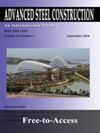焊接箱形截面高温暴露后残余应力演化的实验研究
IF 1.7
3区 工程技术
Q3 CONSTRUCTION & BUILDING TECHNOLOGY
引用次数: 1
摘要
残余应力的存在会显著影响钢结构的刚度和疲劳寿命。对焊接箱形截面在室温下产生的残余应力进行了广泛的研究。然而,关于火灾暴露后残余应力发展的数据有限。由于温度引起的塑性变形和蠕变应变对钢的残余应力分布有很大的影响。为了给理论模型和火灾后的设计建议提供基准数据,本文给出了焊接箱形截面火灾后残余应力的实验研究结果。试验采用截面法进行,考虑了两种常用钢材,即标称屈服应力为235MPa的低碳钢Q235和标称屈服应力为460MPa的高强钢Q460。分别在200℃、400℃、600℃和800℃温度下对试样进行残余应力测试,并将其冷却至室温。试验数据清楚地表明,随着试样温度的升高,残余应力显著降低。进一步利用试验结果,提出了Q235和Q460钢焊接箱形截面温度残余应力的简化关系式。本文章由计算机程序翻译,如有差异,请以英文原文为准。
Experimental study on evolution of residual stress in welded box-sections after high temperature exposure
: Presence of residual stresses can significantly influence the stiffness and fatigue life of steel structures. The extent of residual stress that develops in welded box-shaped sections at room temperature is extensively studied. However, there is limited data on the development of residual stresses after fire exposure. Such fire exposure has great influence on the residual stress distribution due to temperature induced plastic deformation and creep strains in steel. In order to provide benchmark data for the theoretical models and post-fire design recommendations, this paper presents results from an experimental investigation on the post-fire residual stresses in welded box-shaped sections. The tests are carried out by sectioning method, and two types of commonly used steels, mild Q235 steel with a nominal yield stress of 235MPa and high strength Q460 steel with a nominal yield stress of 460MPa are considered. The residual stresses were evaluated after exposing the specimens to 200 ℃ , 400 ℃ , 600 ℃ and 800 ℃ and cooling down to room temperature. Data from the tests clear show that the residual stresses decrease significantly with increase in specimen temperature. Further, results from the tests are utilized to propose simplified relations for temperature induced residual stresses in welded box-section of Q235 and Q460 steels.
求助全文
通过发布文献求助,成功后即可免费获取论文全文。
去求助
来源期刊

Advanced Steel Construction
CONSTRUCTION & BUILDING TECHNOLOGY-ENGINEERING, CIVIL
CiteScore
2.60
自引率
29.40%
发文量
0
审稿时长
6 months
期刊介绍:
The International Journal of Advanced Steel Construction provides a platform for the publication and rapid dissemination of original and up-to-date research and technological developments in steel construction, design and analysis. Scope of research papers published in this journal includes but is not limited to theoretical and experimental research on elements, assemblages, systems, material, design philosophy and codification, standards, fabrication, projects of innovative nature and computer techniques. The journal is specifically tailored to channel the exchange of technological know-how between researchers and practitioners. Contributions from all aspects related to the recent developments of advanced steel construction are welcome.
 求助内容:
求助内容: 应助结果提醒方式:
应助结果提醒方式:


